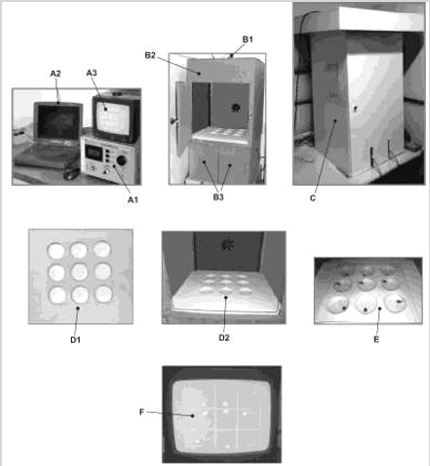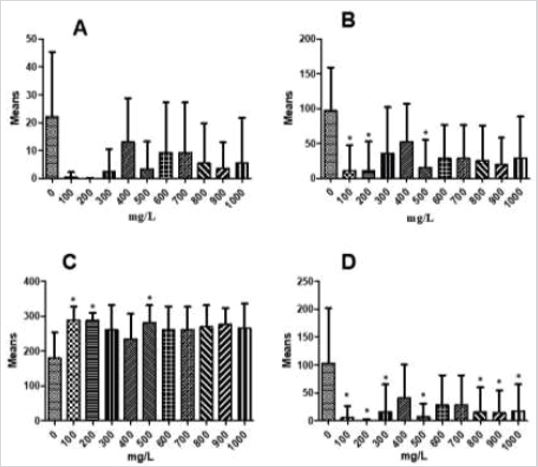Image Analisy Biomonitoring System: A Technique Modification for Biomphalaria sp.
ABSTRACT
The biological responses should be combined with toxicological assessments that is, commonly performed using toxicity acute tests because they are simple to perform and produce quick results. The technique modification for Biomphalaria sp by Image Analisy Biomonitoring System was purpose of this work to develop an adaptation biomonitoring system for aquatic organism, using a small volume of test solution with the use of disposable culture dishes. This technique modification for behavioral biomonitoring system has proven to be a useful tool to detect sublethal effect that could be used as a new protocol biomonitoring.
KEYWORDS
Biomonitoring technique; Image analysis; Biomphalaria sp.
INTRODUCTION
The biological responses should be combined with chemical analyses and with toxicological assessments that are, commonly performed using toxicity acute tests because they are simple to perform and produce quick results, frequently evaluating the lethal dose for 50% of the test organism. According to Scott [1], in the acute toxicity tests with chemical product when the chemical effect of low toxicant exposure is not sufficient to kill the specimen it unable them to function in ecological context because their normal is changed. Gerhardt [2] related that the behavior of an animal is a link between physiological and ecological processes when studied the Whole effluent toxicity testing with Oncorhynchus mykiss survival and behavioural response to a dilution series of a mining effluent in South Africa.
The first study at the Institute Oswaldo Cruz monitoring using a technique involving time-lapse cinematography was developed for studying the behavioral repertoire of planorbids in laboratory conditions. Observations were carried out within a chamber with controlled light and temperature; recording was done by single frame shooting at 10 second intervals, with synchronized strobed flash [3,4].
Sarquis and collaborators, evaluated the effect of niclosamide on the behaviour on mollusc in laboratory conditons that was monitored through videomex-V® (Columbus Instruments, Ohaio, USA), which is an Image Analysis Biomonitoring Sistem (IABS) according to the schematic described by Magalhães [3] and collaborators, testing fish. The purpose of this work was to develop an adaptation biomonitoring system for aquatic organism, using a small volume of test solution with the use of disposable culture dishes.
MATERIAL AND METHODS
For tests with Biomphalaria glabrata an static system was developed, consisting of following components: an image analyzer (Videomex-V®, Columbus Instruments, USA) (Figure 1A1), which uses a software denominated “Multiple Object Distance Traveled (MODT); a video camera which send the digitalized image of animals to a monitor (Figure 1B1); a registering cabinet, built in wood (dimension 36 × 36 × 45cm) (Figure 1B2 and C); a cabin with internal lighting for four fluorescent lamp of 15w, located on the top side for not occur diffuse shadows with soft lighting, an aquarium built in acrylic covered with white insulfilm (dimension: 35 × 35 × 25cm; capacity: 30L), with two acrylic exposing chambers inside divided in 2 boxes (9,5 × 5,0 × 2cm) (Figure 1B3) [5]; a styrofoam plate on dimenssão 35cm x 35cm x 2cm at its other thin Styrofoam plate surface coated with rubberized camuça with nine (9) cavities depth of 0.5cm by 5.5cm in diameter, to support culture plates (Figure 1D1 and D2), this Styrofoam plate containing wells was placed on the glass aquariums (Figure 1E) and set the camera’s focus to the monitor display.
For assays with Biomphalaria glabrata (10-12mm standard size) of Sumidouro, Rio de Janeiro, RJ, maintained in aquaria with dechlorinated water and fed with lettuce in the laboratory. Each snail was individualized in culture plates (Figure 1E), placed a volume of 10mL per plate of the dose to be tested for the experimental group and/or control and covered with a transparent glass plate 3.0mm thick (22.5cm x 22.5cm) and a microcomputer containing a software to receive data from Videomex-V® and generate a spreadsheet in Excel format (Figure 1A2).
The snails were subjected to aqueous extracts of Moringa ovalifolia seed, prepared in the laboratory at doses 100mg/L, 200mg/L, 300mg/L, 400mg/L, 500mg/L, 600mg/L, 700mg/L, 800mg/L, 900mg/L and 1000mg/L (experimental group) e distilled water (control group). The total number of animals used in the tests were 297 snails, to assess the behavioral effect with small volume of solution.
The modification of the proposed technique is the use of the polystyrene support on acrylic tanks that receive large volumes of liquid, for monitoring fish and mollusc by culturing plate on polystyrene support, using small volume. Each test was carried out for 2h and before the registering, the snail was acclimatede for 10min to the exposure chambre. After that, the activity analysis of biomonitoring (Figure 1F) was sent to a Videomex-V®, Columbus Instruments, USA), which uses a software denominated “Multiple Object Distance Traveled (MODT).
The test period was conducted in 24 sections and a 5min break by section, the recording parameters for Distance travelled, is the total distance (mm); Ambulatorial time, is the total number of seconds during the section which spent in travelling movement; Stereotypic time, is the total number of seconds during the session and Resting time is the total number of seconds during the session, which was spent resting.
The results showed that at the end of the study period, behavioral parameters evaluated by mean and standard deviation and analysis of variance using ANOVA, and post-test Bonferroni multiple comparisons (Graph Pad v.5), data were not significant, compared the control group and treated. Ambulatory time presented p=0.7787; stereotyped time, with p=0.4930; time at rest, with p=0.3116 and distance, with p=0.9653. However, with these results, when compared to the control, the extract doses caused changes in the behavior of snails. The parameters ambulatory time, stereotyped time and distance, the answers were under control and the parameter time repose doses showed above the control value responses. The results in Figure 2 show that in the study period for 30 minutes was possible to observe a significant response in the behavior of snails.
The behavioral effects of the stressor with the new modified technique on animals showed that within 30 minutes of exposure parameter, ambulatory time, the doses (experimental group) were not significant when compared to the control group with p=0.0474. In parameters, stereotyped time and rest time, doses of 100mg/L, 200mg/L and 500mg/L, were statistically significant, with p=0.0274 and p=0.0137, respectively. In the parameter distance, doses of 100mg/L, 200mg/L, 300mg/L, 500mg/L, 800mg/L, 900mg/L and 1000mg/L, it was statistically significant, with p=0, 0041, in the period.
Santos et al. [6] studied the behavioral response of Poecilia vivipara for experimental infections Acanthocollaritrema umbilicatum using image analysis system, obtaining significant results for parameters, stereotyped time and rest time, corroborating our findings to Biomphalaria glabrata. According to Sarquis et al. [7] evaluated the effect of Bayluscide WP 70® on the behavioral kinetic of Biomphalaria straminea in the laboratory, using a period of 3h monitoring, with significant results. In our work, we used a 2h period, which also showed significant results, between treated and control groups. We conclude that monitoring by image analysis system with the technical modification to Biomphalaria sp using Videomex-V equipment can be a useful tool in monitoring aquatic organisms under adverse effects, using small volumes, with positive results demonstrated that work.
REFERENCES
- Scott GR, Sloman KA, Rouleau C, Wood CM (2003) Cadmium disrupts behavioural and physiological responses to alarm substances in juvenile rainbow trout (Oncorhynchus mykiss). J Exp Biol 206: 1779-1790.
- Gerhardt A (1998) Whole effluent toxicity testing with Oncorhynchus mykiss (Walbaum 1792) survival and behavioral response to a dilution series of a mining effluent in South Africa. Arch Environ Con Tox 35(2): 309-316.
- Magalhães DP, Cunha RA, Buss DF, Santos JAA, Baptista DF (2007) Behavioral response of the zebrafish Danio rerio to sublethal stress by sodium hypochlorite-evaluation of a method of toxicological essay by real- time biomonitoring in the laboratory. Ecotoxicology 16(5): 417-422.
- Pierre OS, Jurberg P, Raymundo JS (1980) Estudo sobre o comportamento dos planorbídeos: I-uma técnica de observação e registro comportamental por cinematografia. Men Inst Oswaldo Cruz 75(1-2): 57-63.
- Ferrão-Filho AS, Cunha R, Magalhães VF, Soares MCS, Baptista DF (2007) Evaluation of sub-lethal toxicity of cyanobacteria on the swimming activity of aquatic organisms by image analysis. J Braz Ecotoxicol Soc 2: 1-8.
- Santos EGN, Cunha RA, Santos CP (2011) Behavioral response of Poecilia vivipara (Osteichthyies: Cyprinodontiformes) to experimental infections of Acanthocollaritrema umbilicatum (Digenea: Cryptogonimidae). Experimental Parasitology 127(2): 522-526.
- Sarquis O, Pieri OS, Cunha RA, Jurberg P (1998) Effect of Bayluscide WP 70® on the Kinetic Behaviour of Biomphalaria straminea in Laboratory Conditions. Mem Inst Oswaldo Cruz 93(Suppl 1): 239-241.
Article Type
Short Communication
Publication history
Received date: September 24, 2021
Published date: September 28, 2021
Address for correspondence
Keyla Nunes Gomes de Farias, Pós-graduanda de Mestrado em Ciências Biológicas e Biotecnologia pela Universidade Federal Fluminense - UFF, Endereço: Outeiro de São João Batista, Brazil
Copyright
©2021 Open Access Journal of Biomedical Science, All rights reserved. No part of this content may be reproduced or transmitted in any form or by any means as per the standard guidelines of fair use. Open Access Journal of Biomedical Science is licensed under a Creative Commons Attribution 4.0 International License
How to cite this article
José AAS, Paloma SS, Keyla NGF, Rodolfo AC. Image Analisy Biomonitoring System: A Technique Modification for Biomphalaria sp. 2021- 3(5) OAJBS. ID.000323.
Figure 1: Schematic diagram of biomonitoring technique modification of image analysis.
A1- Videomex-V; A2- Microcomputer; A3- Monitor; B1- Video Camera; B2- Record cabin in acrylate; B3- two
independent opaque glad aquarium; C- cabin illumination; D1 and D2- Styrofoam plate surface coated with
rubberized camuça with 9 cavities; E1- Styrofoam platecontaining culture plates and Biomphalaria glabrata snails
covered with glass plate; E2- monitoring diagram of Biomphalaria glabrata snails.
Figure 2: Modified technique results for behavioral study using an Image analysis Biomonitoring System under Biomphalaria glabrata, A: The parameter ambulatory time, doses were not statistically significant (p>0.05). The tests were conducted with three replications.




